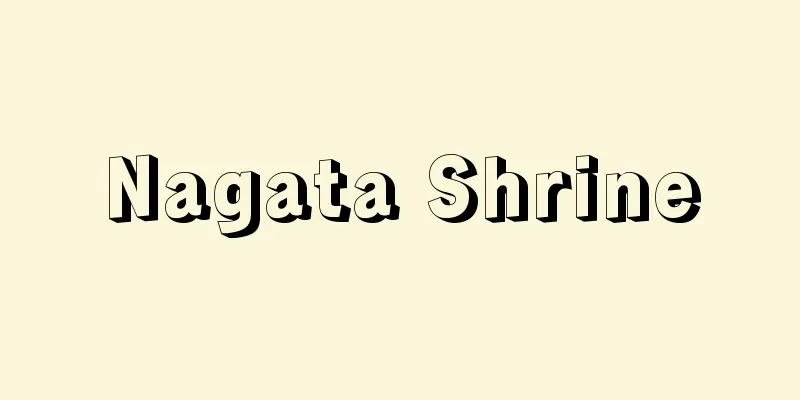Nagata Shrine

|
It is located in Nagata-cho 3-chome, Nagata-ku, Kobe. It enshrines Kotoshironushi-no-kami. In the section on the first year of the regentship of Empress Jingu in the "Nihon Shoki," it is said that on her way back from Silla, at the water gate of Muko, Empress Jingu received divine instruction from Kotoshironushi-no-kami to "enshrine me at Nagata," and had Musume Nagahime of Yamashironeko enshrined at this ancient shrine. In 806 (Daido period), 1) 41 households were granted the title of divine gift. In 859 (Jogan 1), the shrine was ranked as a Myojin Taisha Shrine under the Engi system. It was given official gifts for the Toshigoi, Tsukinami, Ainame and Niiname festivals, and was revered by the Imperial Court. Since the Middle Ages, it has also been worshipped by samurai, and Toyotomi Hideyoshi donated 55 koku of land to the shrine. Under the Meiji system, it was a medium-sized shrine with official gifts. The annual festival is held on October 18th, and the following day, the 19th, a parade ceremony of the phoenix palanquin is held. The black lacquered gilt bronze portable shrine in the shrine's possession is said to date back to the early Kamakura period, and is a national important cultural property. It is beloved by Kobe residents along with Ikuta Shrine and Minatogawa Shrine, and January 1st is known as "Osada-san's New Year," with many people coming from far and wide to make their first shrine visit of the year. In addition to traditional Shinto rituals such as the O-Oni-Shiki ceremony on Setsubun in February, new festivals such as the Glasses Thanksgiving Festival on April 1st and the Commerce and Industry Festival from April 30th to May 3rd are also popular, and the shrine is crowded with worshippers who arrive early in the morning on the 1st and 15th of each month. [Junichi Kamata] The worship hall. Kobe City, Hyogo Prefecture © Kobe International Tourism and Convention Association Nagata Shrine Source: Shogakukan Encyclopedia Nipponica About Encyclopedia Nipponica Information | Legend |
|
神戸市長田区長田町三丁目に鎮座。事代主神(ことしろぬしのかみ)を祀(まつ)る。『日本書紀』神功(じんぐう)皇后摂政(せっしょう)元年の条に、神功皇后が新羅(しらぎ)よりの帰途、武庫(むこ)の水門(みなと)で、事代主神の「われを長田にまつれ」との神誨(しんかい)を受け、山背根子(やましろねこ)の女長媛(むすめながひめ)に祀らせられたとある古社で、806年(大同1)神封41戸、859年(貞観1)従(じゅ)四位下、延喜(えんぎ)の制で名神(みょうじん)大社、祈年(としごい)・月次(つきなみ)・相嘗(あいなめ)・新嘗(にいなめ)祭の案上の官幣にあずかるほか朝廷の崇敬を受け、中世以降武家の信仰も厚く、豊臣(とよとみ)秀吉は社領五十五石を寄せた。明治の制で官幣中社。例祭10月18日、翌19日鳳輦(ほうれん)の渡御式がある。社蔵の黒漆(くろうるし)金銅製神輿(みこし)は鎌倉時代の初期のものとされ、国の重要文化財である。神戸市民に生田(いくた)神社、湊川(みなとがわ)神社とともに親しまれ、1月1日は「長田さんのお正月」と遠近よりの初詣(はつもう)ででにぎわう。二月節分の追儺(ついな)式のような古式豊かな神事とともに、4月1日の眼鏡感謝祭、4月30日~5月3日の商工祭など新規の祭礼も盛んで、毎月1日、15日は早朝よりの参拝者でにぎわう。 [鎌田純一] 拝殿。兵庫県神戸市©一般財団法人神戸国際観光コンベンション協会"> 長田神社 出典 小学館 日本大百科全書(ニッポニカ)日本大百科全書(ニッポニカ)について 情報 | 凡例 |
Recommend
Durg-Bhilainagar (English spelling)
Durg is a city in the district of Durg in the sout...
Amphiphila
...Garden grasses are also grasses of the grass f...
Ono Harukaze - Ono Harukaze
Years of birth: unknown. An official in the early ...
Buntaro Adachi
Anthropologist and anatomist. Born in Izu, Shizuo...
Ishikawa Island
Part of Tsukudajima in Chuo Ward, Tokyo. During t...
Blue Gang - Chimpanzee
One of China's secret societies, also known as...
Non-ferrous metals industry
Non-ferrous metals is a general term for metals ot...
Amaka - Amaka
…Hammocks were first introduced to Western Europe...
FRP - Force Resilience
A composite material made by adding fibers such as...
Lamium purpureum (English spelling) Lamium purpureum
…[Murata Gen]. … *Some of the terminology that me...
Family: Fan Sharks
… [Classification, Systematics] Rays found in the...
Moriyo
The tomb of Emperor Wu of the Western Han Dynasty...
Patterned Cross - Etsukijuji
…(2) A T-cross, which has a long lower line and a...
Akamanma - Akamanma
Another name for Polygonum gracilis. Also called ...
Eight-grade wage system
China's wage system. The majority of workers a...




![Date [town] - Date](/upload/images/67cc22f182f65.webp)




